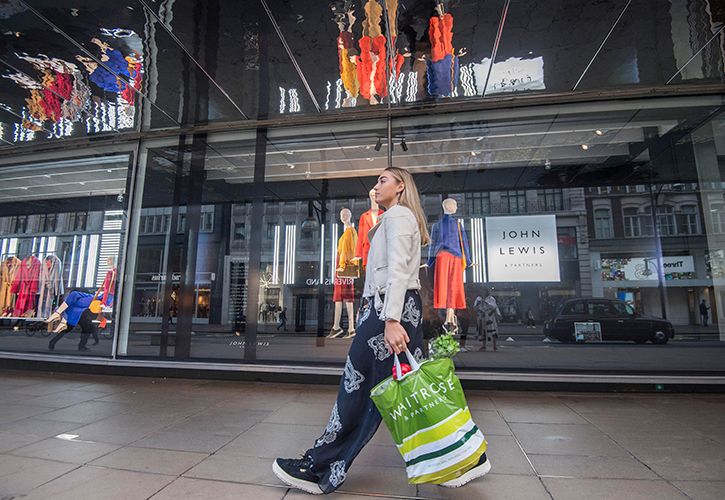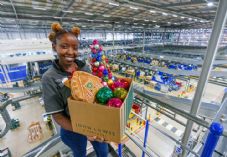UK DIY News
John Lewis Partnership: First Half Losses Of £99m

The John Lewis Partnership has published unaudited interim results for the 26 weeks ended 30 July 2022.
RESULTS SUMMARY
- Our business resilience and employee-owned model means we can prioritise support for our Partners, customers, communities and suppliers during unprecedented cost of living crisis.
- First half loss(1) of £99m, or £92m before exceptional costs, largely due to the combination of cost inflation not fully passed on to customers, impact of cost of living crisis, unwinding of Covid shopping patterns and investments to support Partners, customers and suppliers.
- Announcing a one-off cost of living support payment - £500 for full-time Partners, less for part-time; increasing lowest rates of pay for Partners; free food over the winter and doubling our financial assistance fund to help with bills; committed £16m to Britain’s pig farmers; £2m support and 2.8 million meals to vulnerable communities.
- Doubling down on Partnership Plan with investments in John Lewis and Waitrose with customer numbers up and a strong focus on value. Sales(2) up in John Lewis by 3% like-for-like(3) to £2.1bn; down in Waitrose by 5% like-for-like to £3.6bn.
- Cost savings of £90m in the half; expanding ‘Lean Simple Fast’ efficiency programme (part of the Partnership Plan) to improve margins and productivity given inflationary headwinds.
- Progress on diversification - new and relaunched financial products and plans to build rental homes taking shape.
- Strong balance sheet with £1.5bn of cash and credit facilities to help weather further shocks.
- Outlook for the rest of the year is highly uncertain owing to the cost of living crisis and its impact on discretionary spending as well as criticality of our Christmas trading period.
Dear Partners,
This is an incredibly sad time for our country. The death of Her Majesty The Queen – who for 70 years has been a constant figure in the nation’s life – is profoundly upsetting. Our thoughts are with King Charles III and The Royal Family at this time.
Today, the Partnership is reporting its half year results. I said at our end of year results in March that the outlook for this year was uncertain: war had just broken out in Ukraine and inflation was elevated and looked to be persistent.
No one could have predicted the scale of the cost of living crisis that has materialised, with energy prices and inflation rising ahead of anyone’s expectations. As a business, we have faced unprecedented cost inflation across grocery and general merchandise.
I know Partners throughout the business are really feeling it, after two tough years of the pandemic and necessary - but difficult - restructuring. My great thanks to everyone for your continuing commitment in these times of uncertainty. I know it has not been easy.
We are responding to the cost of living crisis by supporting those who need it and by stepping up our efficiency programme. We are forgoing profit by making choices based on the sort of business we are, led by our Purpose - ‘Working in Partnership for a happier world’ - by helping our Partners, customers, communities and suppliers.
PERFORMANCE
This half year we made a loss before tax and exceptional items of £92m, compared to a profit of £69m in the same period last year and a loss of £52m three years prior (i.e. the last pre-Covid half). This is before exceptional items, principally reducing the size of our London office space. Including exceptional items, we made a loss before tax of £99m (loss before tax of £29m in 2021/22 and a profit before tax of £192m in 2019/20, which included the benefit of closing the defined benefit pension scheme).
It is not unusual for us to make a loss in the first half of the year - we have done so in three of the last four half years. Our trading is heavily skewed to Christmas with most of our profits coming in the last quarter of the year.
The loss was largely due to two main factors:
- Inflation has affected consumer spending. We have more customers year-on-year in both brands (up 6% in Waitrose and 4% in John Lewis) but they are spending less. Inflation has increased our costs, which means we have to do more to meet our original efficiency targets because we have not passed on all of the increased costs to our customers;
- Post-pandemic customer trends. We have seen in-store spending rebound compared to last year. Online remains elevated compared to pre-pandemic levels; we believe this shift is permanent. We have seen customers move their discretionary spending from high margin, big ticket household items to restaurants and holidays - from dining room furniture to dining out.
Waitrose
Waitrose sales were £3.6bn, down 5% like-for-like on a year ago (down 5% in total); up 7% on a like-for-like basis on three years ago (up 4% in total). During the pandemic, Waitrose benefited from bigger baskets as customers were restricted by the pandemic, dining out less and doing fewer shops.
Customer numbers have held up, transactions were up 14% year-on-year, but basket sizes are smaller by nearly a fifth. Online shopping continues to be important, accounting for 15% of sales; significantly up on before the pandemic and 5% below the pandemic peak of around 20%. Nearly seven in ten baskets include a product from the Essential range. Total customer numbers are 13.4 million, up 6% year-on-year.
Waitrose Trading operating profit fell by £93m to £432m due to a combination of volume decline and inflationary pressures being partially offset by a more favourable profit mix and cost savings.
John Lewis
John Lewis sales were £2.1bn, up 3% like-for-like on last year (up 3% in total). Against three years ago, John Lewis sales were up 13% like-for-like (up 4% in total). This has been driven by a return to shops. The share of sales in shops has averaged 41% for the half year, compared to 26% last half year, during the pandemic, and 60% before Covid. City Centre stores have come back most strongly with the return to more office working.
Fashion has been the best performing category, growing 25% compared to last year with strong performance in holiday wear, as people returned to travel and summer breaks. Conversely, our home and technology categories, which performed strongly during the pandemic, declined year-on-year.
The impact of the cost of living - and specifically growing concerns about inflation and energy costs - is evident in patterns of spending. ANYDAY - our great value own-brand - saw sales rise 28% on last half year. Energy saving items also attracted high demand - air fryers up 56%; smart thermostats up 8%. Customer numbers have been strong, with half a million more people shopping with John Lewis than a year ago. Total customer numbers are 12.2 million, up 4% year-on-year.
John Lewis Trading operating profit has been maintained at £295m compared to last year.
RESPONSE TO THE COST OF LIVING CRISIS
Partners: We are the lifeblood of the business - not just employees but owners. We have doubled (to £800,000) financial assistance for Partners facing hardship. We are making an active choice to spend £45m to help our Partners, in addition to the April 2022 pay increase and Bonus:
- We will provide free food at work for 14 weeks over winter;
- In response to Partners’ opinion and the direct influence of our Partnership Council, especially its Partner Committee, we are making a one-off cost of living payment to Partners equal to £500 per full-time Partner (pro-rated for part-time Partners);
- We are increasing the entry level pay for Partners by 4%, costing £10m in the second half.
Customers: We have been extremely considered about how and where we pass on cost inflation to our customers. For example, over 95% of school uniform items have had a price freeze or reduction this year, conscious that these are an essential item. In John Lewis, following the retirement of ‘Never Knowingly Undersold’, we are investing £500m into prices during the financial year. We improved point of sale credit for big ticket items and are testing a new loans product through our financial services arm. Customers benefited from £46m in money-off vouchers through the MyWaitrose loyalty scheme and we have just refreshed our My John Lewis loyalty programme. Customers continue to have great opportunities to shop value through Essential Waitrose and ANYDAY ranges.
Suppliers: We took the decision to invest £16m in British pig farmers to ensure not just their survival but their ability to continue to meet high animal welfare standards.
Communities: In the half we donated more than £2m to charities to help families through challenging times, and provided the equivalent of 2.8 million meals through FareShare.
PARTNERSHIP PLAN - YEAR 2
We continue to deliver our five-year Partnership Plan, which we’re adapting to contend with the cost of living crisis. For example, we are expanding our existing efficiency programme - known as Lean Simple Fast. Our immediate focus is on simplifying business processes, making products easier to return to get products back on sale quicker and improving the way stock moves round the business. We were originally targeting a cost reduction of £300m by year 2 of the Plan, this financial year. We are forecasting to achieve this and intend to exceed it significantly over the life of the Plan. Savings in this first half year were £90m.
We are also significantly investing in our brands:
- John Lewis relaunched earlier this month for ‘All Life’s Moments’ alongside a complete refresh of our main John Lewis & Partners mid-tier brand;
- Waitrose relaunches soon with an even sharper focus on quality, service and sustainability;
- The rollout of the John Lewis ‘shop within a Waitrose shop’ continues - expanding from 49 currently to 88 stores by the end of the year;
- The trial of a new concept John Lewis format launches early in 2023;
- Our new partnership with Dobbies and an expanded partnership with Deliveroo are taking Waitrose to new customers;
- We are making good progress with our plans to diversify the business. In financial services, we are trialling a new loan product and relaunched our pet insurance product. Plans to develop rental homes (‘build to rent’) are taking shape.
OUTLOOK
The outlook is uniquely uncertain. We believe we are well placed to navigate the current inflationary headwinds. First, we have a strong balance sheet, which helps us navigate through trading volatility with total liquidity at £1.5bn (cash of £1.1bn and facilities of £0.4bn). Second, the loyalty of our customers and a deep understanding of their changing habits and needs. Third, the dedication of our Partners who provide great service for our customers.
A successful Christmas is key for the business given the first half. We will need a substantial strengthening of performance, beyond what we usually achieve in the second half, to generate sufficient profit to share a Partnership Bonus with Partners. Much will depend on the wider economic outlook and consumer sentiment.
For our part, we want to give our customers a memorable and affordable Christmas, with Christmas markets in 13 John Lewis stores and 60 new Waitrose products.
Time and again we have been tested as a Partnership. We have always come through - and stronger - by being mindful of the challenges but also open to new opportunities. We will do so again.
Sharon White
Partner & Chairman
1 Loss before Tax
2 All references to sales are Total trading sales which includes VAT, sale or return and other non-cash accounting adjustments
3 We report sales using two measures: in total and like-for-like. 'In total' is the comparison between the statutory balances for two periods of time (e.g. this year to last year). 'Like-for-like' sales are the ‘in total’ sales after adjustments to remove the impact of shop openings and closures. Waitrose like-for-like sales excludes fuel. Like-for-like sales gives a better comparison of our underlying performance
Source : John Lewis Partnership
Insight DIY always publishes the latest news stories before anyone else and we find it to be an invaluable source of customer and market information.











































